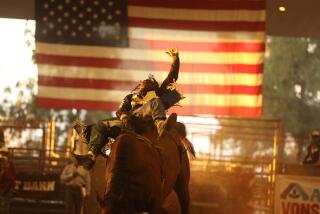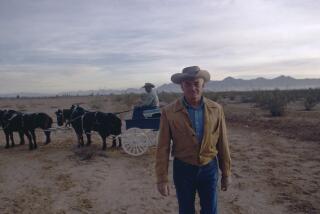THE MONITOR
In 2003, Fox aired “Man vs. Beast,” a series of preposterous competitions between humans and animals that proved beyond any sliver of a doubt that Fox could leave no sensationalistic reality television idea alone. What it didn’t do, though, is answer the root question: Who’s really in control?
Man vs. BeastNow, a couple of more shows are weighing in on the eternal debate -- “Jockeys,” the new Animal Planet would-be soap opera reality series (9 and 9:30 p.m. Fridays), and “Toughest Cowboy,” the Mark Burnett-produced rodeo competition on Spike TV (11 p.m. Thursdays), now in its third season. (It previously aired on Fox Sports Network.)
Control is not the only theme at play here, but it is a crucial one. On both programs, people battle against, or with, an animal for the thrill of sport. And in both, there is the illusion that humans are in charge.
“Toughest Cowboy” documents the third season on the alternative-rodeo circuit in which competitors, who typically specialize in one event, must compete in three disciplines in the same night: bareback horse riding, saddle bronc riding (riding a horse with a saddle), and bull riding. “Three-event cowboys,” the participants are called, but “extreme masochists” would be just as accurate.
In this world, cowboy is not just a job description, it’s an ethic -- when needing to perform through pain, contestants invariably say they need to “cowboy up” (as in “man up,” but more so.) Similarly, it’s tough to tell the difference between cowboys who are celebrating victory and those nursing defeat: They’re equally stoic.
Without an understanding of what separates a good ride from a great one or a merely tolerable one -- and though this show often resembles a broadcast on ESPN2, there’s precious little useful color commentary -- “Toughest Cowboy” can be numbing to watch. That is, until someone gets hurt, which happens frequently enough that the show begins to echo “ER.”
At the beginning of a recent competition, the rodeo commissioner Tommy Joe Lucia ran down a partial list of the wounded: “Chad, you got an injured finger. Jared, you’re sore. Eric, you got a collarbone problem.” These are some of the finest, most skilled athletes in the world at these tasks, but even they are not impervious to injury -- which reminds me that the unspoken truth of “Toughest Cowboy” is that these bulls and horses are mercurial and fearsome and they deserve their own show.
The racehorses sprinting through “Jockeys” are far more enigmatic, presented as blank pages, more or less, upon which a good rider can imprint his or her stamp. (None of the “Toughest Cowboy” contestants are women, but a couple of the featured jockeys on this series are.)
Compared to any of the rodeo events, horse racing seems at first blush far more comprehensible. Yet after four episodes of “Jockeys,” this sport, on which billions of dollars are staked every year, has the feel of the arbitrary. When Mike Smith, a Hall of Fame jockey, gets to ride a young, unbeaten horse, Zenyatta, he looks as if he’s just been given an incredible Christmas gift, not like someone who’s been winning horse races for almost 30 years. Of the jockeys, only Joe Talamo, cocky and possessed of a goofy, blunt-featured handsomeness in his late teens, evinces a developed personality both on and off the horse and a self-assuredness that seems correlated to his success.
Mostly, the jockeys feel tragic, especially the other young ones, none of whom approach Talamo’s achievements. Kayla Stra, a young female rider from Australia, struggles to establish herself in America as a consistent force, finishing both first and last in races. And then there’s another jockey, a second-generation horse racer, who admits to flipping, a jockey practice of throwing up just-ingested food so as to not gain weight. His first win came last week, but it felt pyrrhic.
The severe body issues that are pervasive in the jockey community are given lip service here -- jockeys are seen in the sauna, trying to sweat off a few precious ounces, and flipping is discussed in passing. But in a sport where bodies are weapons, the conversation feels scant. By contrast, on “Toughest Cowboy,” practically all there is to talk about is bodies. On these men, the physiognomy of their faces and the landscapes of their bodies are documents of physical hardship. And even though each week, more and more of these men are kicked, bruised and crumpled, they invariably pick themselves up for the next ride.
Last week, Jared Green, the cowboy who’d taken the most punishment, was sent home. “What went wrong,” he said, “was I started thinking about hurting and injuries instead of riding and winning.”
They might not be able to control the animals, but they can control themselves.
--


